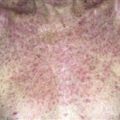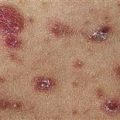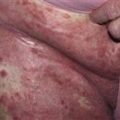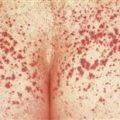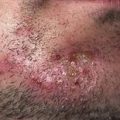106
Scleroderma
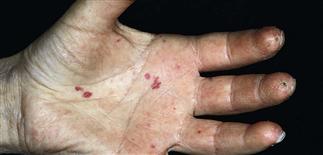
The skin on the fingers is tight and contracted, with digital fingertip crusting indicating prior calcification and ulceration. Mat telangiectasias are scattered on the palms.
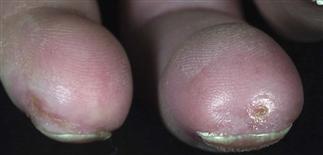
Digital ulceration of the fingertips is a painful consequence of the vascular insult of scleroderma.
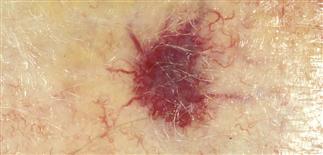
Mat-like telangiectasias are part of the CREST syndrome. Other findings are Raynaud disease, esophageal dysmotility, sclerodactyly and calcification.
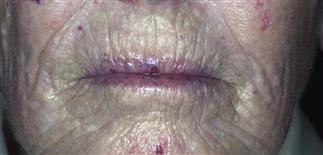
Oral contracture and narrowing of the mouth orifice are seen in scleroderma, along with mat-like telangiectasias.
DESCRIPTION
Idiopathic fibrosing condition with diffuse or limited involvement. Diffuse involvement can affect entire skin, associated with serious internal complications from organ fibrosis and vascular abnormalities. Localized variant associated with CREST syndrome (calcinosis, Raynaud disease, esophageal dysmotility, sclerodactyly, and telangiectasia); more indolent course.
HISTORY
• Rare. • More common in women. • Peak onset between 30 and 50. • Men, older aged, black individuals have worse prognosis. • Interstitial lung disease and pulmonary arterial hypertension are pulmonary complications; lung involvement most common cause of death. Shortness of breath and dry cough are common presentations. • Renal involvement affects 10–15% of patients. • Survival roughly predicted by extent of skin involvement within 1 year of diagnosis. • Best prognosis: sclerodactyly only. Truncal involvement heralds worst prognosis.
PHYSICAL FINDINGS
• Raynaud’s phenomenon may precede onset of scleroderma. • Early on, patients may complain of intense pruritus; affected skin is erythematous and swollen. Sclerosis occurs and skin is smooth, yellowish, firm. Skin appears tight, bound down. Nail folds may show dilated, tortuous capillaries. Earliest changes may be most notable around mouth and on hands; there is loss of the normal facial expression lines, difficulty in opening mouth, and lips appear thin with radial furrowing. Trophic ulceration, gangrene may occur on fingertips. Diffuse calcification may occur within skin. • Late changes: hyperpigmentation or depigmentation, often seen on upper chest. Hair follicles often retain pigment while adjacent skin hypopigmented. Alopecia late, partial or complete. • Limited form associated with Raynaud disease may precede sclerosis. • Heart, gastrointestinal tract, lungs, kidneys may be affected. • Scleroderma renal crisis typically occurs within first 5 years. • Calcinosis can ulcerate in late scleroderma or CREST. • Associated antinuclear antibody patterns: homogeneous, speckled, nucleolar. Nucleolar most specific. • Scl-70 associated with truncal scleroderma, pulmonary fibrosis; renal disease less common. • Anticentromere antibody (speckled pattern) highly specific for CREST syndrome. • Homogeneous pattern: polymyositis–scleroderma overlap. • Antibodies to ssDNA: linear scleroderma.
TREATMENT
• No reliable and effective treatment to reverse or prevent fibrosis; treatment-refractory. Angiotensin-converting enzyme inhibitors for scleroderma renal crisis effective. • Multidisciplinary approach for managing complications. Treat Raynaud disease with behavior modification for cold avoidance, calcium channel blockers nifedipine 10 mg b.i.d. or t.i.d. or amlodipine 2.5 mg q.d. • Physical and occupational therapies important. • For pruritus: Sarna lotion or Pramosone lotion 2.5%. • No smoking, trauma prevention. Meticulous wound care for ulceration. • Patient education materials: Scleroderma Foundation (http://www.scleroderma.org).

